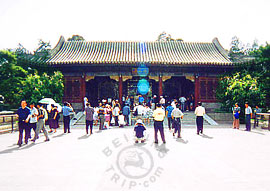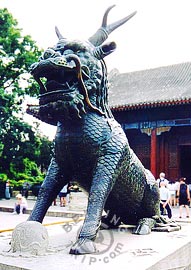 East Palace Gate
East Palace Gate
 The East Palace Gate (Donggongmen) is the main entrance to the Summer Palace. It has three doors, the one in the center being exclusively for the emperor and the empress, and the two side doors for nobles and ministers. The three characters, Yi He Yuan (Summer Palace), on the plaque of the gate, were written by Emperor Guangxu, the last but one emperor of the Qing Dynasty (1644-1911). This emperor is said to have worked at calligraphy specially so as to give a good account of himself in handwriting. The stone carving leading to the middle door has a design of two dragons, symbol of imperial dignity, playing with a ball.
The East Palace Gate (Donggongmen) is the main entrance to the Summer Palace. It has three doors, the one in the center being exclusively for the emperor and the empress, and the two side doors for nobles and ministers. The three characters, Yi He Yuan (Summer Palace), on the plaque of the gate, were written by Emperor Guangxu, the last but one emperor of the Qing Dynasty (1644-1911). This emperor is said to have worked at calligraphy specially so as to give a good account of himself in handwriting. The stone carving leading to the middle door has a design of two dragons, symbol of imperial dignity, playing with a ball.
In front of the East Palace Gate stands a tall Pailou, an arched gateway in ancient style. The words on it suggest that enchanting scenery will be revealed once visitors pass through it. With a history of over 200 years, the Pailou, decorated with 176 painted golden dragons and 36 golden phoenixes, fully demonstrates the magnificence of the imperial residence.
 Hall of Benevolence and Longevity
Hall of Benevolence and Longevity

The Hall of Benevolence and Longevity (Renshoudian) was a place where the emperor temporarily conducted his business. It was originally built in 1750, and named Qinzhengdian (Hall of Industrious Government), which reminded the emperor to be diligent in transacting state affairs while relaxing in the garden. Destroyed by fire in 1860, the hall was rebuilt and given its present name, Renshoudian. The words, which translate as 'Benevolence and Longevity', were taken from the Analects of Confucius, to imply that the emperor who applied a policy of benevolence would live a long life.In the hall, a throne, a wall screen, decorative fans made of peacock feather, incense burners, crane-shaped lights remain laid out as they originally were. The wall screen is quite exceptional, for it has nine dragons and 226 examples of the Chinese character for'Longevity', in different styles.
In front of the hall, there are bronze phoenixes and dragons, with hollow abdomens. When incense was burnt inside, they would smoke, adding aroma to the atmosphere during the ongoing court in the hall. In the courtyard, four unusual stones, dark in color and with holes, represent the four seasons of the year. To the north of the hall, visitors may observe a well, Yannianjing (Well of Prolonging Life). Empress Dowager Cixi is said to have recovered from sunstroke after drinking the water from the well and bestowed on it the name.
 Go to the Next Attractions: Hall of Jade Ripples, Garden of Virtue and Harmony & Hall of Joyful Longevity
Go to the Next Attractions: Hall of Jade Ripples, Garden of Virtue and Harmony & Hall of Joyful Longevity